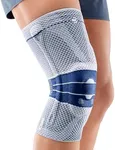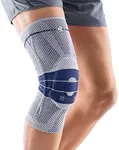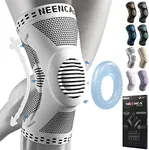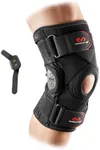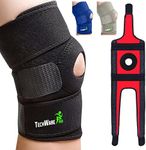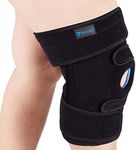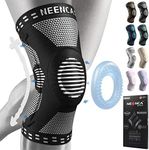Buying Guide for the Best Knee Braces For Arthritis
Choosing the right knee brace for arthritis can make a big difference in your comfort and mobility. The main goal is to find a brace that provides enough support to reduce pain and swelling, while still allowing you to move freely. It's important to consider how severe your arthritis is, what activities you want to do while wearing the brace, and how comfortable the brace feels during daily use. Always try to match the brace to your lifestyle and needs, and remember that a good fit is essential for the brace to work effectively.Type of BraceThere are several types of knee braces, such as sleeves, wraparounds, hinged braces, and unloader braces. This spec refers to the overall design and intended use of the brace. Sleeves are simple and provide mild support, making them good for mild arthritis or general comfort. Wraparounds offer moderate support and are easy to put on, suitable for people who need a bit more stability. Hinged braces provide strong support and are best for those with more severe arthritis or instability. Unloader braces are designed to shift weight away from the affected part of the knee, which is helpful for people with arthritis on one side of the knee. To pick the right type, think about how much support you need and what activities you plan to do while wearing the brace.
Level of SupportThe level of support describes how much stability and protection the brace offers. Light support is good for mild pain and everyday activities, moderate support is better for more noticeable discomfort or light exercise, and high support is needed for severe arthritis or when you need to prevent the knee from moving in certain ways. Consider your pain level and how much your knee tends to give out or feel unstable when choosing the right support level.
Material and BreathabilityThe material of the brace affects comfort, durability, and how much your skin can breathe. Common materials include neoprene, fabric blends, and elastic. Neoprene is supportive and warm but can get sweaty, while fabric blends and elastic are lighter and more breathable. If you plan to wear the brace for long periods or during physical activity, look for breathable materials to avoid irritation and discomfort.
Adjustability and FitAdjustability refers to how well you can customize the brace to fit your knee. Some braces have straps or Velcro closures, while others are slip-on. A good fit is crucial for comfort and effectiveness. If your knee size changes due to swelling, or if you want to wear the brace over clothing, adjustable braces are a better choice. Always check sizing guides and, if possible, try the brace on to ensure it fits snugly but not too tight.
Ease of UseEase of use means how simple it is to put on, take off, and adjust the brace. Some braces are designed to be very easy to use, which is important if you have limited hand strength or dexterity due to arthritis. If you struggle with fine motor skills, look for braces with large straps or simple closures.
Mobility and Range of MotionThis spec refers to how much you can move your knee while wearing the brace. Some braces are very supportive but can limit bending or straightening your knee, while others are more flexible. If you need to walk, climb stairs, or exercise, choose a brace that allows enough movement for your activities. If you need maximum stability, you may have to accept a bit less mobility.

